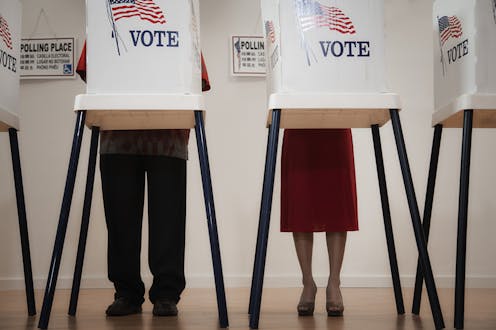
Voting will begin in many states in just a few weeks – Alabama became the first state to begin sending out mail-in ballots on Sept. 11, 2024. It’s one of 10 states that send mail-in ballots to voters more than 45 days before Election Day.
Every state’s regulations and procedures are different, so it is vital that you understand the requirements and opportunities to vote where you live.
Perhaps the biggest problem with American democracy is that so few people actually participate: In 2016, 40% of eligible American voters didn’t cast a ballot. In 2020, 34% of people who could have voted just didn’t.
Check your registration
Make sure that you are registered to vote at your current address. You may not have voted in a while, you may have moved or changed your name, or you may have forgotten whether you were properly registered the last time you voted. Your state’s secretary of state office or local board of elections may be a good place to start. You can also visit www.vote.org. It took only a few minutes online for me to verify my own registration and voter ID number.
If you need to change your name or address, it basically involves filing a new voter registration request.
Not registered? Register to vote now
As of this writing, there is still time to register, in every state. September is National Voter Registration Month.
You can register to vote now at Vote.gov or various other sites, and you can encourage your friends to do the same.
The process of registering doesn’t take long. In fact, Rock the Vote, a nonpartisan nonprofit focused on encouraging young adults to vote, says it takes an average of two minutes or less to go through the process. You may need your driver’s license or state-issued ID card, depending on the state.
Make a plan to vote
After you verify your registration, or register for the first time, it’s important to find out how to actually cast your ballot.
Make sure you know where your local in-person polling place is and what hours it will be open on Election Day.
Do you want to vote before Election Day? In many communities, you can go to a town office or other location and fill out a ballot, just as you would on Election Day. This allows you to vote in person on your own schedule. But the location for early in-person voting may be different from your regular polling place.
Or perhaps you want to vote by mail.
Voting by mail
Mail-in voting is safe and reliable, both in terms of protecting the integrity of your vote and keeping you safe from the spread of disease. Amid the COVID-19 pandemic in 2020, 46% of U.S. votes were cast by mail.
There are two kinds of mail balloting systems: universal vote-by-mail and absentee balloting. Some states, such as Vermont and Oregon, are mailing ballots to every registered voter. In other states, such as Minnesota and New Mexico, you must submit a formal request in advance of the election. In some of those states, such as South Carolina and New Hampshire, you need to provide a reason why you wish to vote by mail – such as that you will be out of town on Election Day or that you have health concerns that cause you to need to avoid large social gatherings.
Find out what your state’s rules are, and if you need to, request your vote-by-mail ballot. It’s also worth checking whether your state will require you to pay postage to mail your ballot – most states do. You can find out the cost and buy stamps ahead of time so you’re ready.
Your state secretary of state’s office or local election board will have a website listing important information, including:
- Upcoming election dates and deadlines
- Voter eligibility requirements
- Voter identification requirements
- Options to receive advance information about candidates and ballot questions
- Tools to look up whether you are registered to vote and to track your mail-in ballot
Set reminders to vote
People set reminders for all sorts of important tasks: paying bills, medical and dental appointments and sending birthday wishes to friends and family. So add voting to your calendar. Set alerts to request a mail-in ballot, to send that ballot back, or to vote early, or to vote on Election Day.
Tell friends and family you are voting
I can’t say it enough: Share what you know about how to register and vote. Every vote that is cast is a vital contribution to the future of your community, your state and the nation as a whole.
There are many ways you can tell people. For instance, you can share your intent to vote on your social media. Or send a text or an email to your family and friends. Or commit to calling 10 people and asking them to vote, and ask them to also call 10 more people. It will all make a difference. This is your democracy. Do your part to preserve and strengthen it.
Do not be intimidated
If you make your plan and follow the rules, you can cast your ballot and be certain that your vote will count.
You may hear about, or see or hear, people challenging voters’ eligibility to cast ballots or making allegations of “widespread” voter fraud and “rigged” elections. Over decades, investigations and audits have shown that election irregularities are rare and not large enough to affect the outcome of races.
It is your right to vote. Exercise that right proudly and make your voice heard.
This article includes material previously included in an article published on Aug. 18, 2020.
Amy Dacey is the executive director of the Sine Institute of Policy and Politics. She is the former CEO of the Democratic National Committee. She has donated to several Democratic campaigns in the 2024 election cycle.
This article was originally published on The Conversation. Read the original article.







